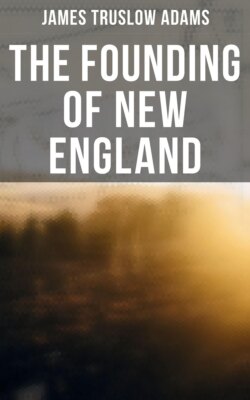Читать книгу The Founding of New England - James Truslow Adams - Страница 7
На сайте Литреса книга снята с продажи.
Notes
Оглавление1. Cf. E. P. Cheyney, European Background of American History (New York, 1904), pp. 3-41.
2. Prowse favors Newfoundland; d’Avezac, Deane, Réclus, Winsor, Brevoort, Eggleston, Winship, Biggar, and Dawson believe in Cape Breton; Biddle, Humboldt, Kohl, Stevens, Kretschmer, and Harrisse point to Labrador. The question is not important, and the alignment is given merely to show the uncertainties of this and other early voyages. The original sources are most accessible to the general reader in C. R. Beazley, John and Sebastian Cabot; London, 1898.
3. In regard to the 1497 voyage, opinion ranges from R. Biddle, Memoir of Sebastian Cabot (Philadelphia, 1831), p. 50, who doubts if the father went, to H. Harrisse, John Cabot (London, 1896), p. 48, who doubts if the son did!
4. S. E. Dawson, “Voyages of the Cabots.” Transactions of the Royal Society of Canada, Series II, 1894, p. 53.
5. Cf.H. Harrisse, The Discovery of North America (London, 1892), pp. 180 ff.; and C. de la Roncière, Histoire de la Marine Française (Paris, 1906), vol. ii, p. 399.
6. Cf.H. Stevens, Historical and Geographical Notes; New Haven, 1869.
7. For the Verrazano voyage, vide B. Smith, An Enquiry into the Authenticity etc.; New York, 1864; J. C. Brevoort, Verrazano the Navigator; New York, 1874; H. C. Murphy, The Voyage of Verrazano; New York, 1875; B. F. deCosta, Verrazano the Explorer; New York, 1881. The Gomez voyage is important but very obscure. The statement by Fiske (The Discovery of America, vol. ii, p. 491) is far too positive. Harrisse (Discovery, pp. 229-43) gives new documents.
8. “The Englishmen, who commonly are lords of the harbors where they fish, and do use all strangers helpe in fishing if need require, accordinge to an old custome of the countrey.” Letter of Anthony Parkhurst, 1578, in Hakluyt, Voyages (Glasgow, 1904), vol. viii, p. 10. H. P. Biggar states that the English were so heavily interested in the American fisheries by 1522, that the Vice-Admiral sent several men-of-war to the mouth of the Channel to protect the returning vessels. Early Trading Companies of New France (Toronto, 1901), p. 20.
9. Cf.W. Heyd, Geschichte des Levantehandels in Mittelälter (Stuttgart, 1879), vol. ii, pp. 514-40.
10. H. J. Mackinder, “The Geographical Pivot of History,” in The Geographical Journal, April, 1904, pp. 421-44.
11. If “these thinges be sett downe and executed duelye and with speed and effecte, no doubte but the Spanishe empire falles to the grounde, and the Spanishe kinge shall be lefte bare as Aesops proude crowe . . . if you touche him in the Indies, you touche the apple of his eye; for take away his treasure, which is neruus belli, and which he hath almoste oute of his West Indies, his olde bandes of souldiers will soone be dissolved, his purposes defeated, his power and strengthe diminished, his pride abated, and his tyranie utterly suppressed.” R. Hakluyt, “A Discourse concerning Western Planting”; Maine Historical Society Collections, vol. ii, p. 59.
12. Hakluyt, Voyages, vol. viii, p. 190.
13. Cited by Alexander Brown, Genesis of the United States (Boston, 1890), pp. 9 f. The original source is not indicated.
14. It is given in Hakluyt, Voyages, vol. viii, pp. 17-23.
15. W. Cunningham, The Growth of English Industry and Commerce (Cambridge, 1892), vol. ii, pp. 31-33.
16. M. J. Bonn, Die Englische Kolonisation in Irland (Stuttgart, 1906), vol. i, pp. 265-373.
17. Brown, Genesis, p. 860.
18. Hakluyt, Voyages, vols. vii, p. 144, and iii, p. 89.
19. Ibid., vol. ii, p. 108; cf. also the earlier charter of Richard II (1391), cited by C. T. Carr, Select Charters of Trading Companies (Selden Society, London, 1913), pp. xi ff.
20. Hakluyt, Voyages, vol. viii, p. 20. Professor H. L. Osgood states that “by the realm was usually meant England, Wales, and Berwick on Tweed.” The American Colonies in the 17th Century (New York, 1907), vol. iii, p. 6. In Gilbert’s charter, the words “realmes of England and Ireland” are used. Scotland, of course, was a separate realm.
21. Brown, Genesis, p. 20.
22. Hakluyt, Voyages, vol. viii, p. 157.
23. S. Purchas, Hakluytus Posthumus, or Purchas His Pilgrimes (ed. Glasgow, 1905), vol. XVIII, p. 302.
24. The clandestine nature of the voyage is proved by B. F. de Costa, “Gosnold and Pring,” in N. E. Historical and Genealogical Register, 1878, vol. XXXII, pp. 76-80.
25. Purchas, Pilgrimes, vol. XVIII, pp. 322-28.
26. “We found the land a place answerable to the intent of our discovery, viz. fit for any nation to inhabit.” “Rosier’s Relation,” in Burrage, Early English and French Voyages (New York, 1906), p. 371. Sir F. Gorges, “A Briefe Narration of the Originall Undertakings, etc., 1658,” in Mass. Hist. Soc. Coll., Series III, vol. vi, p. 50.
27. Calendar of State Papers, Colonial, America and West Indies, 1574-1660, p. 695 (hereafter cited as Cal. State Pap., Col.); J. P. Baxter, Sir Ferdinando Gorges and his Province of Maine (Prince Society, Boston, 1890), vol. i, p. 65.
28. The river was formerly thought to be the Kennebec. Cf. Burrage, Early Voyages. In Burrage’s edition of Rosier’s Relation (Gorges Society, Portland, 1887), there is an exhaustive survey of the literature.
29. H. S. Burrage, Beginnings of Colonial Maine (Portland, 1914), p. 32.
30. Marc Lescarbot, Histoire de la Nouvelle France; Paris, 1609.
31. Ellis, The Red Man, p. 242; J. Winsor, “The Rival Claimants for North America,” American Antiquarian Society Proceedings, 1894, pp. 415-17.
